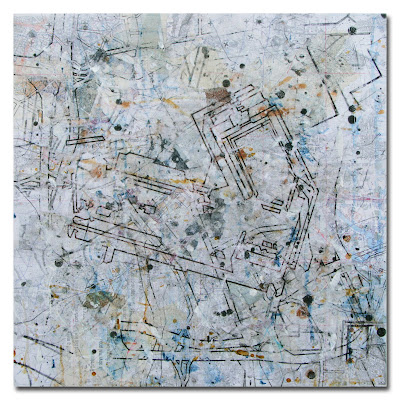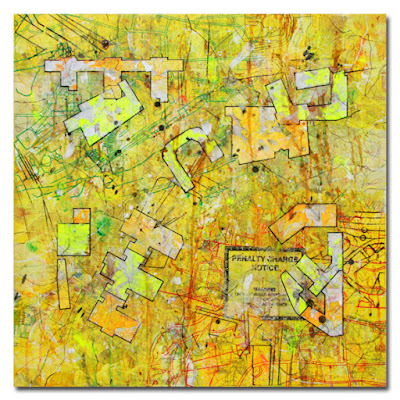 |
'Deleuzian Cartography 5', Paper Collage & Mixed Media on Panel,
600 mm x 600mm, 2025 |
As promised, here's the next 'Deleuzian Cartography' painting (can I still accurately describe works like these as 'paintings'? - I'm not sure). This is the first one to expand in scale, and it definitely feels like some kind of escape from the world of tiny pieces I've been inhabiting for rather too long. We're still not exactly talking huge here - this is a standard (for me) square format at dimensions I'd normally think of as 'medium'. Nevertheless, it's definitely pleasing to have a bit more real estate to work with again, and perhaps implies a boost in overall confidence levels too.


Given the cartographic impulses at play in these pieces, scale and expansiveness feel like key issues. As a mapping concept, scale feels fairly straightforward, although we can quickly find ourselves dealing with more the emotional/intuitive aspects of distancing, detail focus, personal relationship to specific terrain etc. In this context, I'd reference the familiar thrill of zooming-in/out in Google Maps, and the instantaneous changes in emotional relationship to territory it affords. I'm also reminded of Borges' very short story, 'On Exactitude in Science' [1.], in which an unnamed Empire produces a 'perfect' map at 1:1 scale, completely covering the terrain with its own representation, and rapidly rendering itself useless in the process. As usual, Borges unlocks a world of philosophical speculation with the most economical of means. A close inspection of my own 'DC' pieces reveals how the collaged/mulched cartographic fragments vary in scale dramatically, indicating the themes of simultaneity and dissolving territorialisation that I've tried to build into them. The intention is definitely not to accurately map things with any degree of overall continuity - exactly the opposite, in fact.

Spatially, it's hardly original to observe that there's only one endless map (ultimately adjusted to wrap around a globe), and a set of arbitrary decisions about how we chop it up. That alone has caused me to speculate what happens as one breaks those boundaries and crosses into the next portion of the chart. Clearly, there's no reasons why any expansion should result in a regular square/rectangular border. Indeed, it feels highly desirable that it shouldn't. To that ends, I've been working for quite a while (under the radar, admittedly,) to produce a variety of paper-based sheets using the same techniques and general aesthetic you see here, but stopping at the point one might term 'backgrounds'. The intention is ultimately to start stitching these together in order to work/map further onto the resulting composites.

What you see here, then, is a more direct stopgap attempt to increase scale by just building a bigger panel and getting on with it. Any reticence in launching into this had to do with uncertainties over the relative scale of individual marks/motifs and the effect that might have on an overall composition. At this stage, (and relatively modest zoom ratio), it appears that the problems are negligible. Given the found/digitised/highly mediated nature of my source imagery, there's not too much the scaling functions of a photocopier, or Photoshop, or even just an old-school OHP, can't overcome. Also, the degree of all-over 'Pollockisation' effects that seem inevitable as this kind of imagery increases in scale seem both enjoyable and appropriate so far. The often monumental examples of Mark Bradford, Julie Mehretu, Cy Twombly, etc. would suggest there's a long distance to travel yet in that respect.

In all honesty, I'm not really sure where all that caution and tentative uncertainty came from of late. However, I do know that if just chopping up larger bits of MDF, embracing risk and accident, and working as quickly as the method allows, are proven ways to break out of that - well then the answer is obvious...
[1.]: Jorge Luis Borges,
'On Exactitude in Science' (Trans. Andrew Hurley), From:
'The Aleph', London/NYC, 1949/1999















































